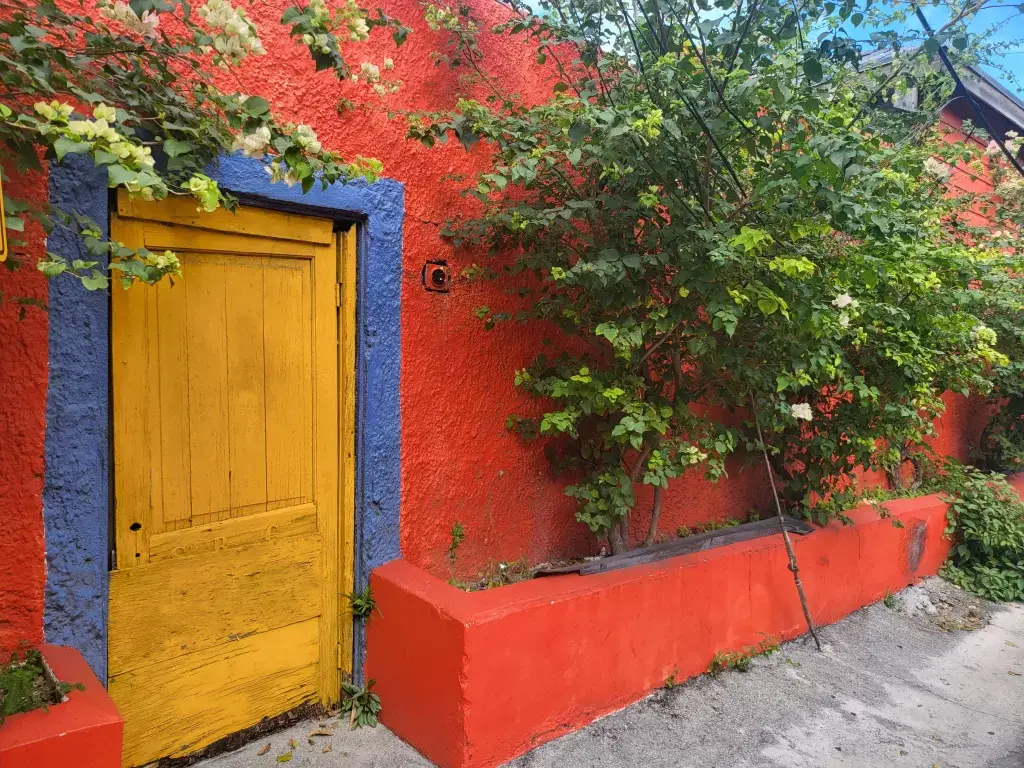Nassau is the bustling capital of the Bahamas, located on the island of New Providence. With its colorful colonial architecture, duty-free shops, and white sand beaches, it’s a popular stop for cruise ships. I think beyond the touristy areas, Nassau has a rich history and culture waiting to be explored on foot.
This 5-hour self-guided walking tour will take you to some of Nassau’s top sites, from historic landmarks to a Caribbean rum distillery. We’ll start downtown at the heart of the city, winding our way through side streets to hidden gems like Pompey Museum. You’ll get a taste of Junkanoo culture at colorful vendor stalls before relaxing on a public beach.
When walking in Nassau, be sure to wear comfortable shoes and bring water to stay hydrated. The weather is generally hot and humid year-round. Apply sunscreen and wear a hat for protection. Streets in downtown Nassau are laid out on a grid pattern, making navigation easy, but be sure to have a map just in case. Slow down and appreciate the colonial architecture along the way. Chat with locals to get insider tips and discover places off the beaten path.
This walking tour will give you a feel for Nassau beyond the cruise port. By exploring on foot, you’ll experience the energy of this vibrant island capital up close. Get ready for a fascinating look into history, culture, and everyday island life!
Your Digital Google Map
Welcome to our self-guided digital map, designed to ignite your wanderlust and stir your sense of adventure. Get ready to explore an array of remarkable locations, each marked with a number that corresponds to a wealth of captivating details. Click here to get the link to your Nassau self-guided Walking Tour.
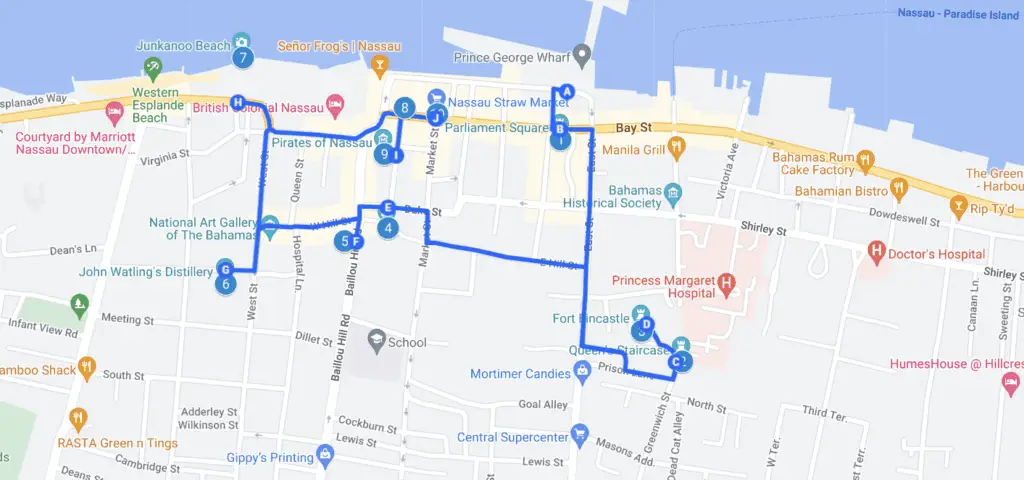
Let’s kick off this expedition with Location #1: Parliament Square. To reach this historical gem, start by walking north from the waterfront on Market Street for about 5 minutes. You’ll spot the pink-hued Parliament building, standing proudly as the focal point of the square. Step inside and marvel at the Neoclassical details and mahogany furniture in the debating chambers.
Now, let’s hop to Location #2: Queen’s Staircase. Head west on Shirley Street for approximately 15 minutes until you reach the impressive staircase. As you ascend the 65 steps made of solid limestone, imagine the incredible labor of the enslaved individuals who carved this masterpiece between 1793 and 1794. Take a moment to soak in the breathtaking views and connect with the rich history of the Bahamas.
This is just the beginning, my friend. Brace yourself for a series of exhilarating discoveries, all just a step away on our self-guided digital map. Let your adventurous spirit guide you, and who knows what wonders you’ll uncover! Happy exploring!
Nassau Parliament Square
Parliament Square is not just any ordinary square, oh no! It’s a haven of remarkable landmarks that tell tales of Bahamian history and culture.
At the very center of Parliament Square stands the enchanting Parliament building. Behold its majestic pink hue, chosen to pay homage to the delicate conch shells that grace the nearby beaches. Constructed during the Victorian era, this architectural gem boasts an impressive octagonal tower and exquisite Neoclassical details adorning its roofline and windows. Step inside, and you’ll find yourself immersed in the debating chambers, where mahogany furniture and sparkling chandeliers set the stage for important discussions.
As you venture forth, your eyes will undoubtedly be drawn to the magnificent statue of Queen Victoria, standing tall in front of the Parliament building. Made from pristine white marble, this regal statue was erected in 1905, serving as a poignant reminder of the Bahamas’ rich history as a British colony.
And let’s not forget the captivating monument on the east side of the square, paying tribute to the esteemed Bahamian politicians Sir Stafford Sands, Sir Roland Symonette, and Sir Etienne Dupuch. These visionary leaders, affectionately known as the ‘Fathers of the Nation,’ played a vital role in guiding the country towards its well-deserved independence.
But my friend, Parliament Square is not just a static collection of statues and buildings; it’s an immersive journey through time and culture. It serves as an ideal first stop for any intrepid traveler seeking to unearth the captivating history of Nassau. Soak in the stories, let the secrets of the square unfold, and fuel your curiosity before embarking on further explorations of this tropical capital.
The Queen’s Staircase
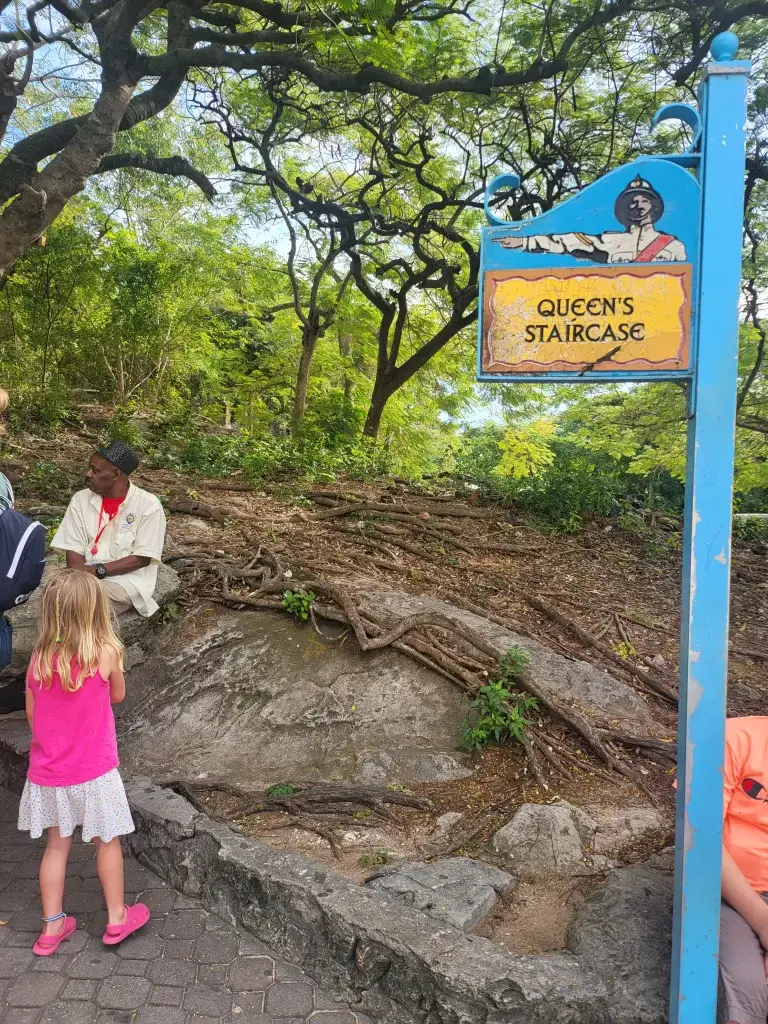
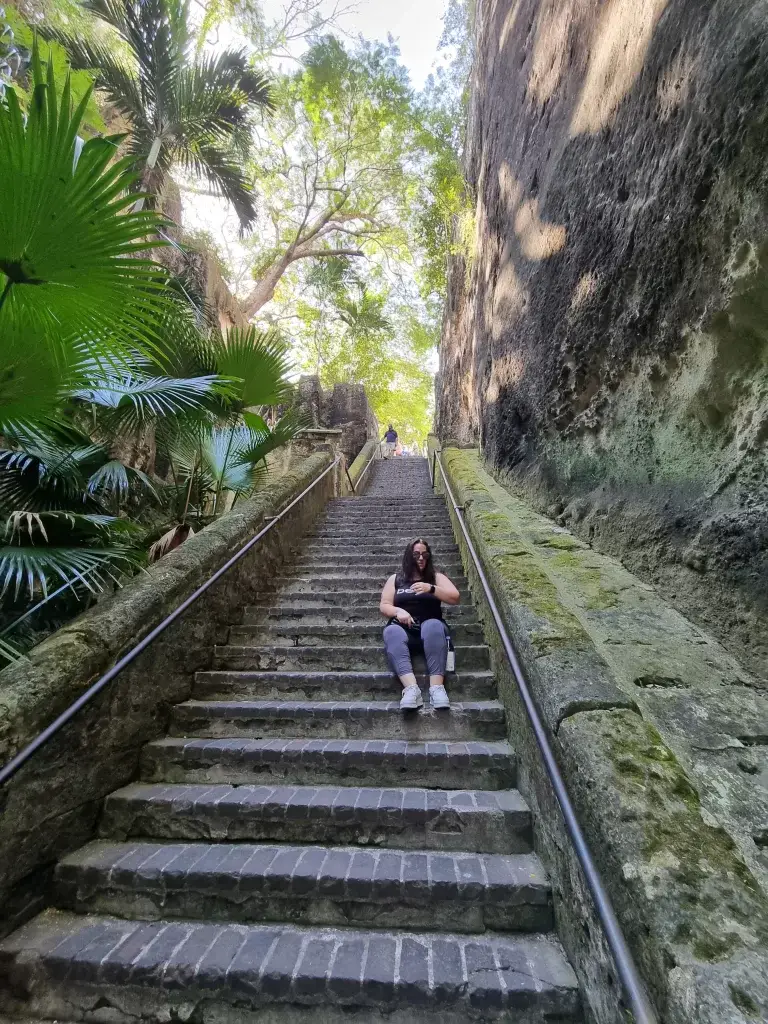
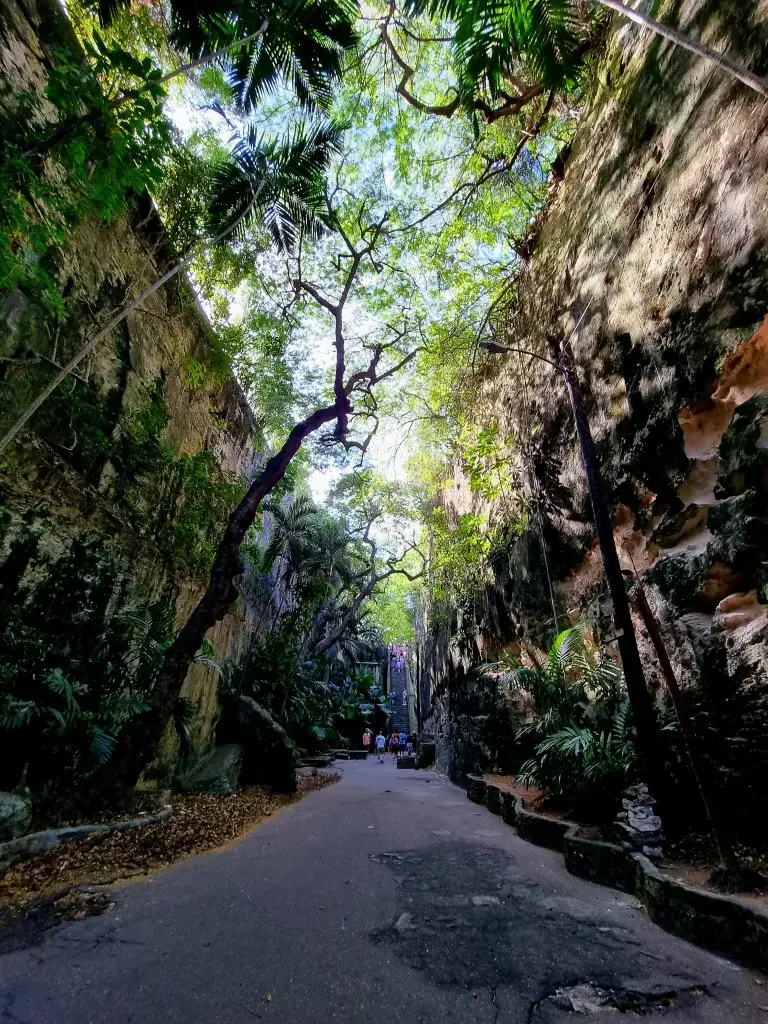
Your next step towards a towering marvel known as the Queen’s Staircase! Rising 66 feet tall, this staircase is a testament to both the Bahamian spirit and the labor of countless souls. With 65 solid limestone steps, this grand structure was given the ominous moniker of the “Stairs of Death” by enslaved individuals who were coerced into carrying heavy loads up its steep incline. Carved between 1793 and 1794, these steps were originally intended to grant beach access to the officers of Fort Fincastle before being lovingly named in honor of the legendary Queen Victoria.
Today, as you approach the mighty staircase, you’ll find yourself surrounded by majestic mahogany and Caribbean pine trees that offer respite from the sun’s warmth. And when the flowers are in bloom, prepare for a vibrant explosion of red, orange, and yellow hues that add a touch of whimsy to your ascent. Along the hillside, you’ll feast your eyes on colossal limestone cliffs adorned with lush moss and creeping plants, creating an awe-inspiring backdrop that harkens back to the annals of time.
As we make our way up the uneven steps, we fully immersed in the history of the Bahamas. Each stone you touch carries with it the weight of the immense labor endured by countless individuals who toiled to create this remarkable landmark. It’s a humbling and awe-inspiring experience that connects you to the past and lets your imagination soar.
Fort Fincastle
Fort Fincastle sits atop Bennet’s Hill and offers incredible panoramic views of Nassau and Paradise Island. The fort was constructed in 1793 by Lord Dunmore, who was the governor of the Bahamas at the time. It was named after Viscount Fincastle, Lord Dunmore’s son.
Fort Fincastle was built to protect Nassau from invading forces and enemy ships. It sits atop the highest point on the island, giving it a strategic position to spot potential attacks. The fort features a tower and a powder magazine, along with cannons that point out to sea.
The architecture of the fort showcases British colonial military engineering. The towers and walls were built from limestone brought over from England along with the cannons. The powder magazine was used to store ammunition and gunpowder for the fort’s defense.
Today, Fort Fincastle serves more as a historic site and popular tourist attraction rather than a functioning fort. Visitors can walk along the fort’s walls and take in panoramic views of Nassau city and harbor. The fort provides insight into the history of the Bahamas and its colonial past under British rule. It’s a can’t miss attraction on any walking tour of Nassau.
Government House
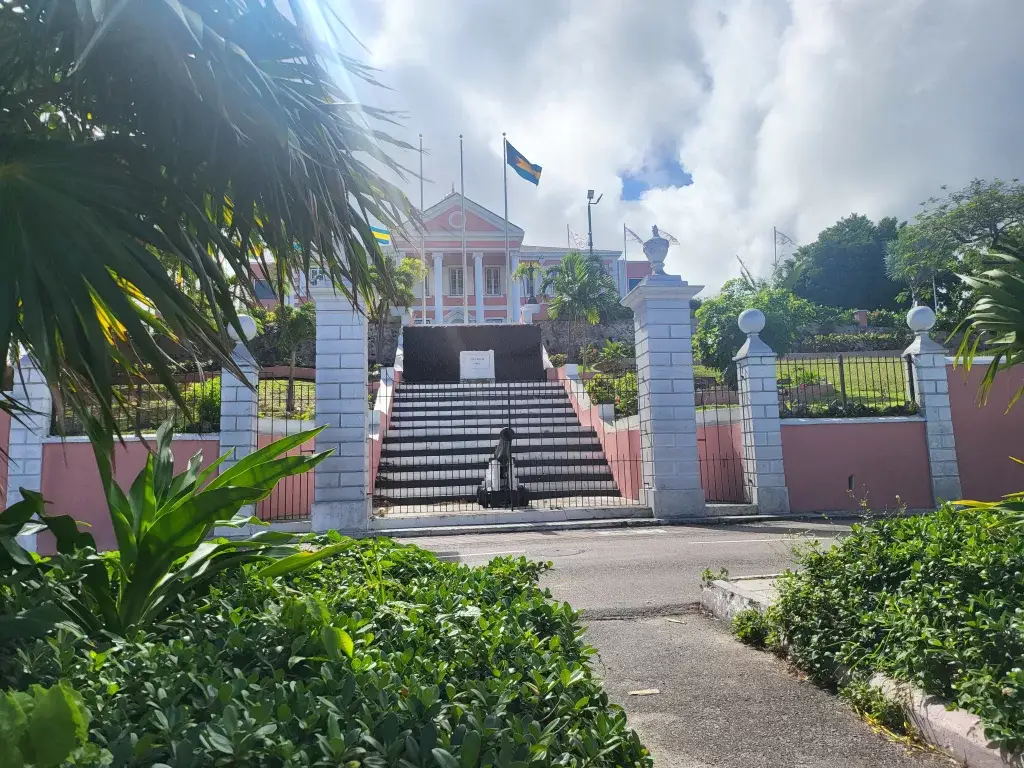
As we explore this enchanting island, we didn’t forget to visit the illustrious Nassau Government House. It’s an absolute must-see! Perched atop Mount Fitzwilliam, Nassau Government House serves as the official residence of the Governor-General of The Bahamas. This architectural masterpiece, constructed in the early 1800s, exudes elegance and a sense of history[1]. With its breathtaking views, sprawling estate, and lush gardens, this place is truly captivating.
While I’d love to provide you with all the nitty-gritty details, like visiting hours and guided tours, they’re a bit elusive. So, I recommend checking with local tourism authorities or the official government website to plan your visit.
So, get your camera ready and prepare to be transported into the elegance of Nassau Government House. This is just the beginning of our exploration together. Stay tuned for more exciting insights on what Nassau has to offer. Until then, embrace your adventurous spirit and let the world be your playground!
Note: Due to the ever-changing nature of travel, please refer to official sources for the most up-to-date information on Nassau Government House visits.
Graycliff
Graycliff is a historic 18th-century Georgian-style mansion that was originally built in 1740 by privateer John Howard Graysmith. Today, it operates as a restaurant, hotel, and cigar company located on West Hill Street overlooking Nassau Harbour.
Graycliff is perhaps best known for its cigars which are handrolled on-site in the Graycliff Cigar Factory. We pass the tour but you can take a 30-60 minute factory tour to see how these premium cigars are crafted. You’ll get to observe cigar rollers at work using techniques that date back over a century. The factory produces around 25,000 cigars per year for both its own Graycliff brand and private labels.
The Graycliff Restaurant is also a highlight, situated in the stunning original mansion. It offers fine Bahamian and international cuisine for lunch and dinner in an elegant, historic setting. The wine cellar has over 250,000 bottles and is said to be the third largest in the world.
So for a taste of history, culture, and cuisine, Graycliff is a must-visit spot on any Nassau walking tour. From its origins in colonial times to its modern reinvention as a dining and cigar destination, it offers a unique window into the story of the Bahamas.
John Watling’s Distillery
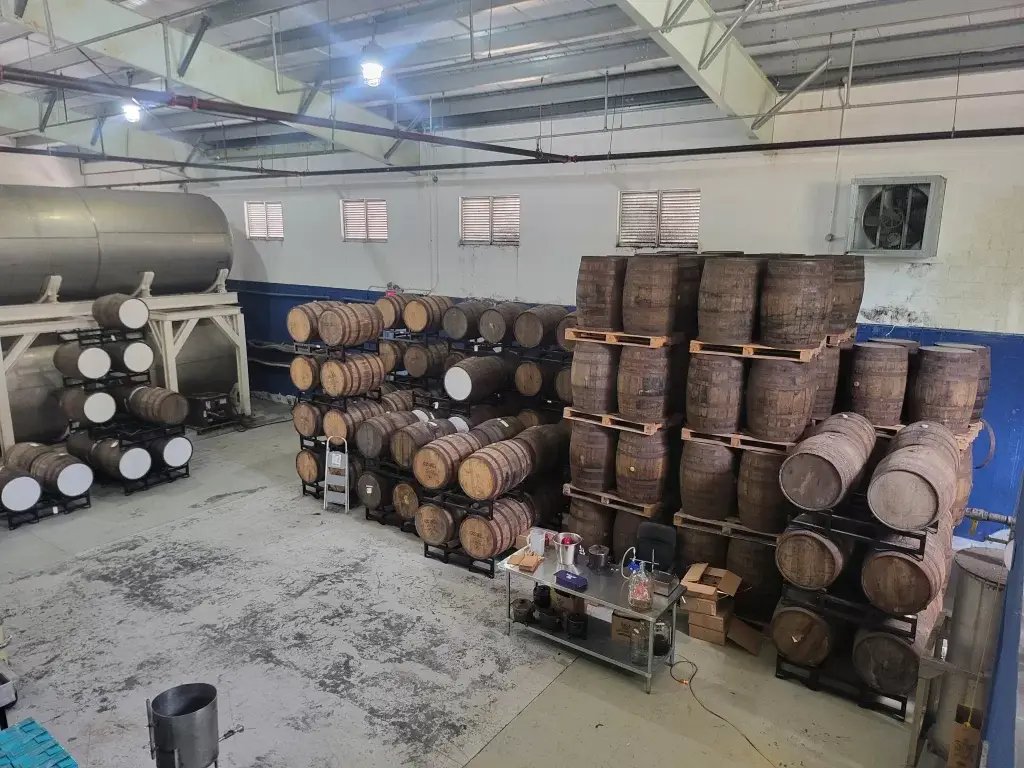
John Watling’s Distillery is a must-visit attraction for rum lovers exploring downtown Nassau. Located on Delancy Street, John Watling’s is the oldest working distillery in The Bahamas.
The distillery was founded in 1788 and originally produced Buena Vista rum. It was renamed John Watling’s in 2003 after the buccaneer John Watling, who was one of the original owners.
At John Watling’s we took free and a fascinating tour to observe the rum production process first-hand. It all starts with molasses, which is delivered directly from the sugar cane fields. The molasses is diluted and then mixed with yeast to start the fermentation process. After fermenting for several days, the mash is then distilled in old-fashioned copper pot stills. The rum is aged for at least two years in handcrafted oak barrels, which gives it its signature flavor and amber color.
A highlight of visiting John Watling’s is sampling their award-winning rums during the complimentary tasting at the end of the tour. You can sip on their Buena Vista label white and amber rums along with their higher-end small batch John Watling’s Pale, Special, and Buena Vista Premium. It’s fascinating to taste the differences that aging makes. Don’t miss an opportunity to shop for unique rum bottles and merchandise at the distillery store.
Spending an hour exploring centuries-old rum history and production at John Watling’s Distillery is one of the most memorable experiences in Nassau for rum aficionados. The distillery’s palpable heritage and hands-on process make it the ideal place to discover Bahamian rum culture.
Junkanoo Beach
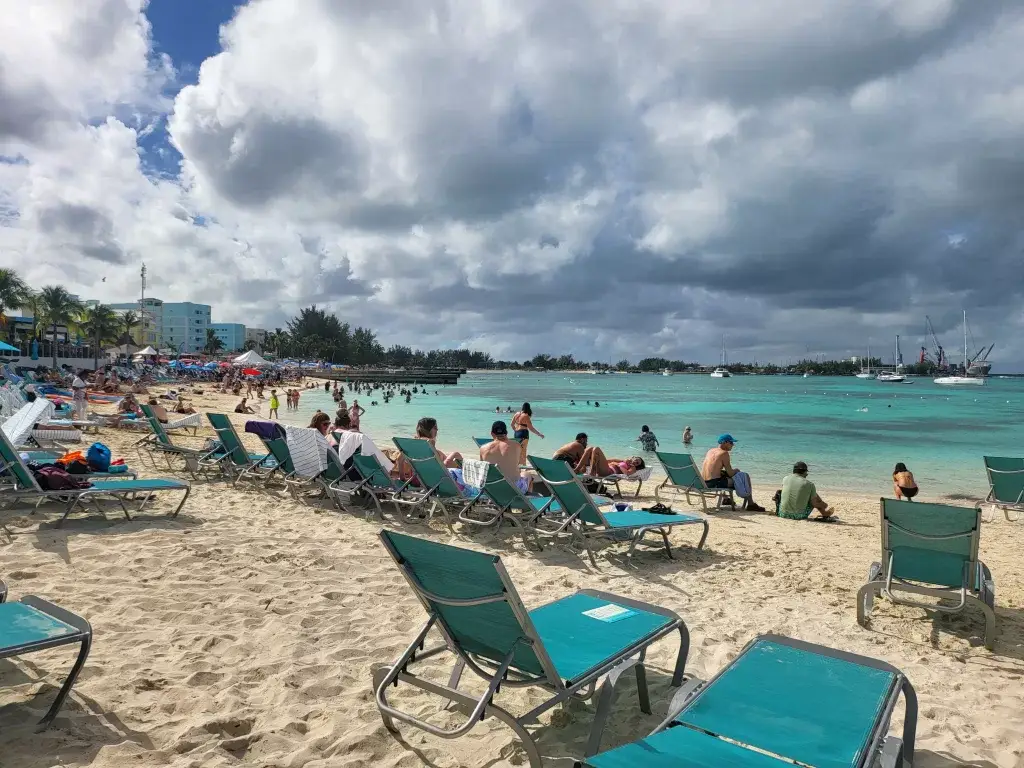
Junkanoo Beach is a popular public beach located on the northwest shore of Nassau. With its soft white sand and calm, shallow waters, it’s an ideal beach for families and those looking to relax.
Several food stands and restaurants are located along the beach, offering quick bites like conch fritters, fish sandwiches, and tropical drinks. Just across the street is the Arawak Cay Fish Fry, which has dozens of booths selling traditional Bahamian seafood dishes like conch salad and grilled snapper.
There are plenty of activities right on Junkanoo Beach. Visitors can rent beach chairs and umbrellas or go snorkeling and paddleboarding. Local hair braiders and vendors also walk along the beach. The best time to visit is on a weekend when you can experience an authentic Junkanoo rush featuring dancers in colorful costumes.
Overall, with its convenient location in downtown Nassau and laidback vibe, Junkanoo Beach is a great place to soak up the sun and get a taste of local Bahamian culture. Spending an afternoon here is a perfect way to relax during a walking tour of Nassau.
Pompey Museum
The Pompey Museum of Slavery and Emancipation is located in an 18th-century building that was once used to house enslaved people. This small but impactful museum provides an in-depth look at the history of slavery in the Bahamas through a variety of artifacts, documents, artwork, and multimedia exhibits.
The museum was founded in 1992 to commemorate the 200th anniversary of the abolition of the transatlantic slave trade. It is named after Pompey, an enslaved African who lived in Nassau in the late 18th century. Pompey is an important figure in Bahamian history, as he was one of the leaders of a major 1790 slave revolt on Bay Street.
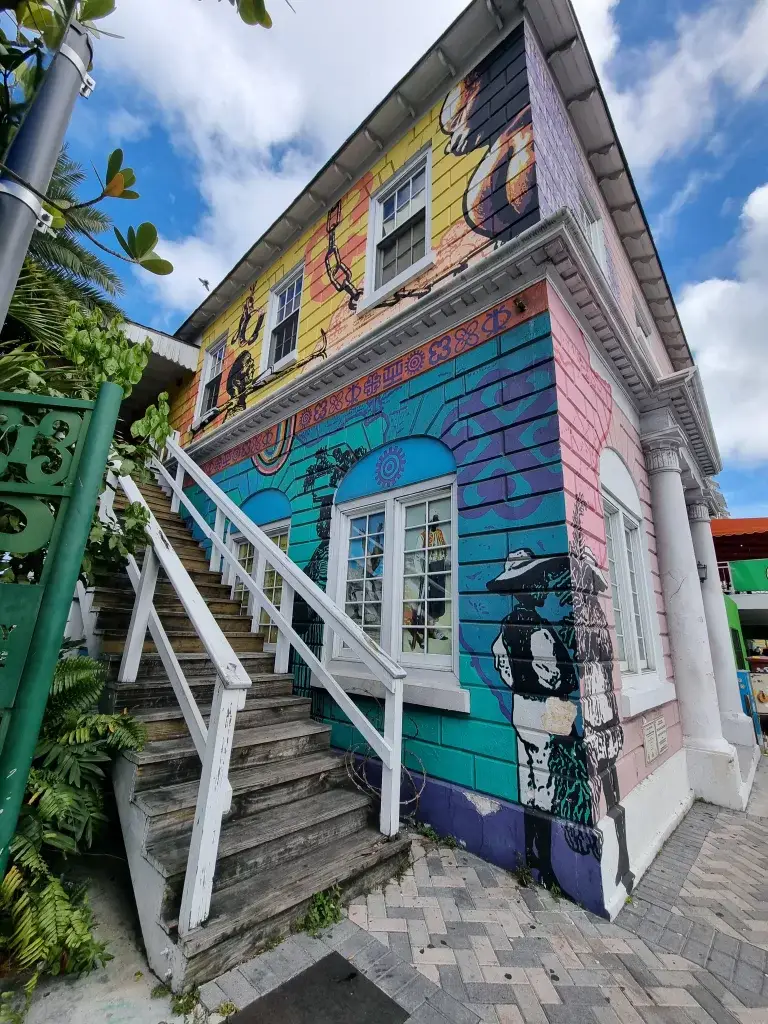
Inside the museum, visitors can view relics from the days of slavery in the Bahamas, including chains, shackles, and branding irons used to restrain and punish enslaved individuals. There are also plantation tools, cookware, ceramics, and other everyday objects that provide insight into the living conditions of enslaved people.
Of particular note is the museum’s collection of rare documents, including estate lists, slave registers, manumission papers, newspaper ads, and correspondence that illustrate the scale and impact of the slave trade in the Bahamas. Visitors can also view examples of traditional African textiles, jewelry, musical instruments, and other cultural artifacts that enslaved people smuggled with them to the Bahamas.
In the art gallery, visitors can see a collection of contemporary and historical paintings that depict images of slavery and its legacy in the Bahamas. The museum also presents multimedia exhibits featuring audio recordings of voices of former slaves describing their experiences.
Overall, the Pompey Museum provides an unfiltered perspective on the traumatic history of slavery in the Bahamas and its enduring impact on Bahamian society. It is an emotionally heavy yet highly educational experience for understanding this pivotal part of Nassau’s history.
Pirates of Nassau Museum

Let me regale you with a tale fit for a pirate’s soul. In the heart of downtown Nassau lies a hidden gem that will transport you back to the thrilling days of swashbuckling adventure – the Pirates of Nassau Museum. Stepping inside this captivating museum was like stepping onto the deck of a pirate ship, surrounded by the sights and sounds of the Golden Age of piracy.
As you wander through its interactive exhibits, you’ll uncover the secrets of notorious pirates, learn about their daring escapades, and even get a taste of life as a buccaneer yourself. From hidden treasure chests to intricate pirate artifacts, every corner tells a story of high seas and daring exploits. So, grab your compass, gather your crew (or go solo for that extra thrill), and set sail for the Pirates of Nassau museum.
It’s a journey you won’t soon forget, filled with laughter, discovery, and a touch of that pirate spirit that lingers in the warm Caribbean breeze. Ready to unleash your inner pirate? Yo-ho-ho, let’s go!
Nassau Straw Market

Welcome to the heart of Nassau, where the Straw Market reigns supreme. As we step into this lively marketplace, we greeted by a symphony of voices, the sweet aroma of fresh conch salad, and the rhythmic sounds of Caribbean music floating through the air.
We found ourself getting lost in a sea of vibrant colors and patterns, each item was a unique story of Bahamian craftsmanship. The skilled artisans pour their heart and soul into every piece, ensuring that you take home a little piece of their culture.
Not only can you find quintessentially Bahamian goods like straw hats and bags, but you’ll also discover a treasure trove of locally-made wooden carvings, shell jewelry, vibrant paintings, and other authentic handicrafts. These one-of-a-kind items make for perfect souvenirs or cherished mementos of your adventures in Nassau.
But the Straw Market is not just a shopping haven, it’s also a vibrant social hub. Prepare for delightful encounters with friendly vendors, who are always ready to share stories, tips, and maybe even a few laughs. Engage in some friendly bargaining as you haggle for the best price – a dance of wit and negotiation that can add a playful element to your shopping experience.
Bonus: Nassau Public Library
The Nassau Public Library has a long history that reflects the changing cultural influences on the Bahamian people. Founded in 1797 by the Library Society of Nassau, it is the oldest library in the country. The original wooden building was financed by wealthy merchants and was located on Shirley Street in downtown Nassau.
Over the years, the library moved to several locations as it outgrew its space. In 1934, it settled into the historic Prince George Wharf building. This neoclassical structure was originally built in 1802 as a customs warehouse. The imposing architecture and harbor views make it one of the most distinctive library buildings in the Caribbean.
Inside, visitors can peruse the Bahamian Archives on the second floor. This collection documents Bahamian history dating back to the 1700s. It includes official government records, personal diaries, photographs, rare books, and genealogical information on prominent Bahamian families. Materials date from the island’s colonial period under British rule to the modern era as an independent nation.
The Nassau Public Library serves an important role in preserving the cultural heritage of the Bahamian people. A self-guided tour of Nassau should include a stop at this historic institution. Browse the archives to gain insights into the nation’s past and appreciate how the library has evolved over time.
Conclusion
This self-guided walking tour of Nassau has highlighted some of the top historical and cultural sites to visit during a 5 hour stay. Nassau has a unique charm from the iconic Queen’s Staircase to the rustic John Watling’s Distillery and the relaxing sands of Junkanoo Beach.
To summarize, we started in bustling Parliament Square before heading up the 65 steps of the Queen’s Staircase carved out of solid limestone by slaves in the 1790s. We then climbed up to Fort Fincastle for panoramic views of the island, followed by a rum tasting at John Watling’s Distillery established in the 1950s.
After learning about Junkanoo traditions at the Pompey Museum, we relaxed on the white sands of Junkanoo Beach and saw celebrity graves at historic Graycliff before ending at the public library.
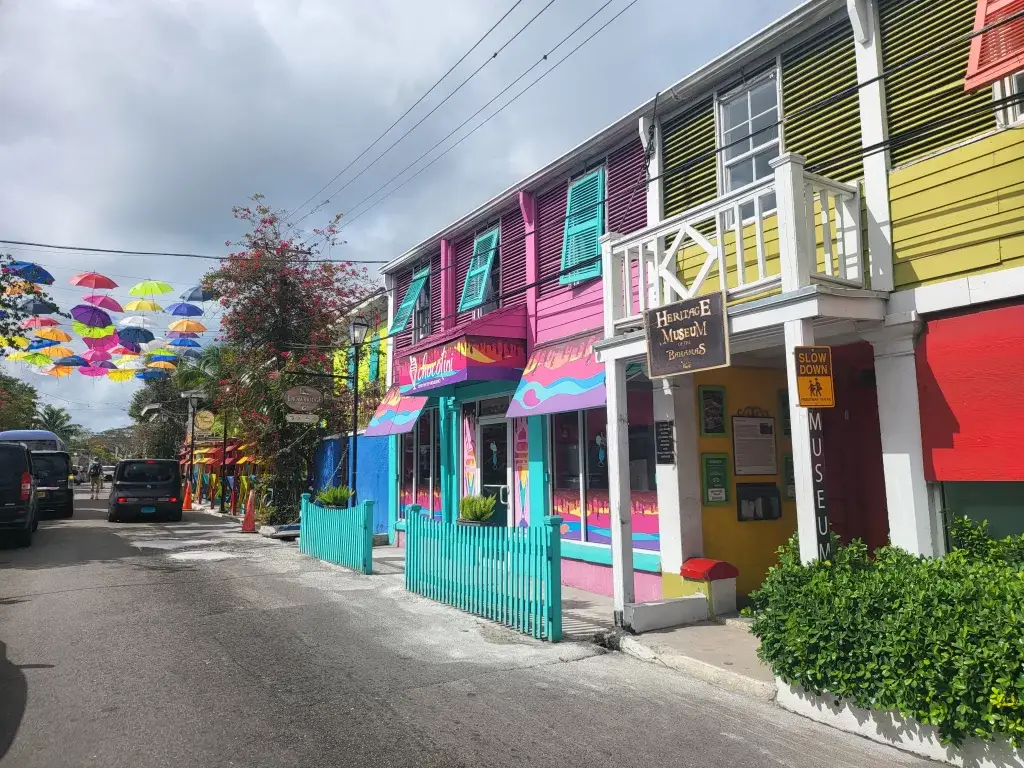
If you have more time to spend in Nassau, consider some of these additional activities:
- Take a snorkeling or scuba diving trip to explore the incredible marine life of the surrounding coral reefs
- Visit Paradise Island to lounge on stunning beaches or try your luck at Atlantis casino
- Take a boat trip to swim with dolphins or stingrays
- Explore more of Nassau’s history and culture at other museums
- Wander through the bustling Straw Market to shop for souvenirs and handicrafts
- Savor delicious Bahamian cuisine like conch fritters, cracked conch, and tropical cocktails
With its unique blend of history, natural beauty, and island culture, Nassau offers the perfect taste of an unforgettable Caribbean vacation. This walking tour has provided a great overview for first-time visitors to help experience the best of Nassau in just 5 hours.
Planning your next trip? Dont forget to check our comprehensive guide Discover The World: The Ultimate Guide to Intuitive Travel Planning.
